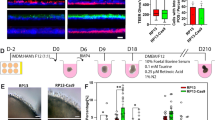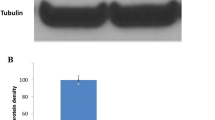Abstract
Prp8 protein (Prp8p) is a highly conserved pre-mRNA splicing factor and a component of spliceosomal U5 small nuclear ribonucleoproteins (snRNPs). Although it is ubiquitously expressed, mutations in the C terminus of human Prp8p cause the retina-specific disease retinitis pigmentosa (RP). The biogenesis of U5 snRNPs is poorly characterized. We present evidence for a cytoplasmic precursor U5 snRNP in yeast that lacks the mature U5 snRNP component Brr2p and depends on a nuclear localization signal in Prp8p for its efficient nuclear import. The association of Brr2p with the U5 snRNP occurs within the nucleus. RP mutations in Prp8p in yeast result in nuclear accumulation of the precursor U5 snRNP, apparently as a consequence of disrupting the interaction of Prp8p with Brr2p. We therefore propose a novel assembly pathway for U5 snRNP complexes that is disrupted by mutations that cause human RP.
This is a preview of subscription content, access via your institution
Access options
Subscribe to this journal
Receive 12 print issues and online access
$189.00 per year
only $15.75 per issue
Buy this article
- Purchase on Springer Link
- Instant access to full article PDF
Prices may be subject to local taxes which are calculated during checkout





Similar content being viewed by others
References
Will, C.L. & Lührmann, R. Spliceosomal UsnRNP biogenesis, structure and function. Curr. Opin. Cell Biol. 13, 290–301 (2001).
Jurica, M.S. & Moore, M.J. Pre-mRNA splicing: awash in a sea of proteins. Mol. Cell 12, 5–14 (2003).
McKie, A.B. et al. Mutations in the pre-mRNA splicing factor gene PRPC8 in autosomal dominant retinitis pigmentosa (RP13). Hum. Mol. Genet. 10, 1555–1562 (2001).
Vithana, E.N. et al. A human homolog of yeast pre-mRNA splicing gene, PRP31, underlies autosomal dominant retinitis pigmentosa on chromosome 19q13.4 (RP11). Mol. Cell 8, 375–381 (2001).
Chakarova, C.F. et al. Mutations in HPRP3, a third member of pre-mRNA splicing factor genes, implicated in autosomal dominant retinitis pigmentosa. Hum. Mol. Genet. 11, 87–92 (2002).
Keen, T.J. et al. Mutations in a protein target of the Pim-1 kinase associated with the RP9 form of autosomal dominant retinitis pigmentosa. Eur. J. Hum. Genet. 10, 245–249 (2002).
Maita, H. et al. PAP-1, the mutated gene underlying the RP9 form of dominant retinitis pigmentosa, is a splicing factor. Exp. Cell Res. 300, 283–296 (2004).
Kiss, T. Biogenesis of small nuclear RNPs. J. Cell Sci. 117, 5949–5951 (2004).
Bertrand, E. & Bordonne, R. Assembly and traffic of small nuclear RNPs. Prog. Mol. Subcell. Biol. 35, 79–97 (2004).
Yong, J., Wan, L. & Dreyfuss, G. Why do cells need an assembly machine for RNA-protein complexes? Trends Cell Biol. 14, 226–232 (2004).
Huber, J. et al. Snurportin1, an m3G-cap-specific nuclear import receptor with a novel domain structure. EMBO J. 17, 4114–4126 (1998).
Jantsch, M.F. & Gall, J.G. Assembly and localization of the U1-specific snRNP C protein in the amphibian oocyte. J. Cell Biol. 119, 1037–1046 (1992).
Romac, J.M.J., Graff, D.H. & Keene, J.D. The U1 small nuclear ribonucleoprotein (snRNP) 70k protein is transported independently of U1 snRNP particles via a nuclear localization signal in the RNA-binding domain. Mol. Cell. Biol. 14, 4662–4670 (1994).
Hetzer, M. & Mattaj, I.W. An ATP-dependent, Ran-independent mechanism for nuclear import of the U1A and U2B′′ spliceosome proteins. J. Cell Biol. 148, 293–304 (2000).
Nesic, D., Tanackovic, G. & Kramer, A. A role for Cajal bodies in the final steps of U2 snRNP biogenesis. J. Cell Sci. 117, 4423–4433 (2004).
Ohno, M., Segref, A., Bachi, A., Wilm, M. & Mattaj, I.W. PHAX, a mediator of U snRNA nuclear export whose activity is regulated by phosphorylation. Cell 101, 187–198 (2000).
Grainger, R.J. & Beggs, J.D. Prp8 protein: at the heart of the spliceosome. RNA 11, 533–557 (2005).
Jackson, S.P., Lossky, M. & Beggs, J.D. Cloning of the RNA8 gene of Saccharomyces cerevisiae, detection of the RNA8 protein, and demonstration that it is essential for nuclear pre-mRNA splicing. Mol. Cell. Biol. 8, 1067–1075 (1988).
Luo, H.R., Moreau, G.A., Levin, N. & Moore, M.J. The human Prp8 protein is a component of both U2- and U12-dependent spliceosomes. RNA 5, 893–908 (1999).
Martinez-Gimeno, M. et al. Mutations in the pre-mRNA splicing-factor genes PRPF3, PRPF8, and PRPF31 in Spanish families with autosomal dominant retinitis pigmentosa. Invest. Ophthalmol. Vis. Sci. 44, 2171–2177 (2003).
Kondo, H. et al. Diagnosis of autosomal dominant retinitis pigmentosa by linkage-based exclusion screening with multiple locus-specific microsatellite markers. Invest. Ophthalmol. Vis. Sci. 44, 1275–1281 (2003).
Ziviello, C. et al. Molecular genetics of autosomal dominant retinitis pigmentosa (ADRP): a comprehensive study of 43 Italian families. J. Med. Genet. 42, e47 (2005).
Testa, F. et al. Clinical phenotype of an Italian family with a new mutation in the PRPF8 gene. Eur. J. Ophthalmol. 16, 779–781 (2006).
De Erkenez, A.C., Berson, E.L. & Dryja, T.P. Novel mutations in the PRPC8 gene, encoding a pre-mRNA splicing factor in patients with autosomal dominant retinitis pigmentosa. Invest. Ophthalmol. Vis. Sci. 43 e-abstract 791 (2002).
Gottschalk, A., Kastner, B., Lührmann, R. & Fabrizio, P. The yeast U5 snRNP coisolated with the U1 snRNP has an unexpected protein composition and includes the splicing factor Aar2p. RNA 7, 1554–1565 (2001).
Stevens, S.W. et al. Biochemical and genetic analysis of the U5, U6, and U4/U6.U5 small nuclear ribonucleoproteins from Saccharomyces cerevisiae. RNA 7, 1543–1553 (2001).
Umen, J.G. & Guthrie, C. A novel role for a U5 snRNP protein in 3′ splice site selection. Genes Dev. 9, 855–868 (1995).
Bordonne, R. Functional characterization of nuclear localization signals in yeast Sm proteins. Mol. Cell. Biol. 20, 7943–7954 (2000).
Achsel, T., Ahrens, K., Brahms, H., Teigelkamp, S. & Lührmann, R. The human U5–220kD protein (hPrp8) forms a stable RNA-free complex with several U5-specific proteins, including an RNA unwindase, a homologue of ribosomal elongation factor EF-2, and a novel WD-40 protein. Mol. Cell. Biol. 18, 6756–6766 (1998).
van Nues, R.W. & Beggs, J.D. Functional contacts with a range of splicing proteins suggest a central role for Brr2p in the dynamic control of the order of events in spliceosomes. Genetics 157, 1451–1467 (2001).
Pena, V., Liu, S., Bujnicki, J.M., Lührmann, R. & Wahl, M.C. Structure of a multipartite protein-protein interaction domain in splicing factor prp8 and its link to retinitis pigmentosa. Mol. Cell 25, 615–624 (2007).
Fischer, U. et al. Diversity in the signals required for nuclear accumulation of U snRNPs and variety in the pathways of nuclear transport. J. Cell Biol. 113, 705–714 (1991).
Boon, K.-L., Norman, C.M., Grainger, R.J., Newman, A.J. & Beggs, J.D. Prp8p dissection reveals domain structure and protein interaction sites. RNA 12, 198–205 (2005).
Steinberg, R.H. Monitoring communications between photoreceptors and pigment epithelial cells: effects of “mild” systemic hypoxia. Friedenwald lecture. Invest. Ophthalmol. Vis. Sci. 28, 1888–1904 (1987).
Faustino, N.A. & Cooper, T.A. Pre-mRNA splicing and human disease. Genes Dev. 17, 419–437 (2003).
Longtine, M.S. et al. Additional modules for versatile and economical PCR-based gene deletion and modification in Saccharomyces cerevisiae. Yeast 14, 953–961 (1998).
Puig, O., Gottschalk, A., Fabrizio, P. & Seraphin, B. Interaction of the U1 snRNP with nonconserved intronic sequences affects 5′ splice site selection. Genes Dev. 13, 569–580 (1999).
Lesser, C.F. & Guthrie, C. Mutational analysis of pre-messenger RNA splicing in Saccharomyces cerevisiae using a sensitive new reporter gene, CUP1. Genetics 133, 851–863 (1993).
Niedenthal, R.K., Riles, L., Johnston, M. & Hegemann, J.H. Green fluorescent protein as a marker for gene expression and subcellular localization in budding yeast. Yeast 12, 773–786 (1996).
Carter, K.C. et al. A three-dimensional view of precursor messenger RNA metabolism within the mammalian nucleus. Science 259, 1330–1335 (1993).
Samarsky, D.A., Fournier, M.J., Singer, R.H. & Bertrand, E. The snoRNA box C/D motif directs nucleolar targeting and also couples snoRNA synthesis and localization. EMBO J. 17, 3747–3757 (1998).
Olson, B.L. & Siliciano, P.G. A diverse set of nuclear RNAs transfer between nuclei of yeast heterokaryons. Yeast 20, 893–903 (2003).
Lin, R.-J., Newman, A.J., Cheng, S.-C. & Abelson, J. Yeast mRNA splicing in vitro. J. Biol. Chem. 260, 14780–14792 (1985).
Boon, K.-L. et al. Yeast Ntr1/Spp382 mediates Prp43 function in postspliceosomes. Mol. Cell. Biol. 26, 6016–6023 (2006).
Bartels, C., Urlaub, H., Lührmann, R. & Fabrizio, P. Mutagenesis suggests several roles of Snu114p in pre-mRNA splicing. J. Biol. Chem. 278, 28324–28334 (2003).
Acknowledgements
We thank P. Fabrizio (Max Planck Institute, Göttingen) for the very generous gift of anti-Aar2p and anti-Snu114p antibodies, O. Cordin (University of Edinburgh) for anti-Brr2p anti-peptide antibodies, M. Spiller for assistance with immunofluorescence staining and microscopy, A. Kutach and C. Guthrie for sharing information before publication, and I. Davis, M. Reijns and D. Tollervey for critical comments. This work was funded by studentships from The Darwin Trust of Edinburgh to K.-L.B. and T.A. and by Wellcome Trust Grants 067311 (J.D. Beggs) and 073988 (C.F.I.) and European Commission grant LSH-2004-518238 (EURASNET Network of Excellence). J.D. Beggs is the Royal Society Darwin Trust Professor.
Author information
Authors and Affiliations
Contributions
K.-L.B. contributed Figures 1, 2, 4c, 4e–h and 5 and Supplementary Figures 1, 3 and 6; R.J.G. contributed Figures 3b, 3c and 4b and Supplementary Figure 2; P.E. contributed Figure 4d and investigated the effects of HA-tagging Prp8p with and without the rp mutations (data not shown); J.D. Barrass performed the RT-PCR and microarray analyses (Supplementary Figs. 4 and 5); T.A. contributed Figure 3a; C.F.I. provided expertise on RP; J.D. Beggs supervised all the work and wrote most of the paper.
Corresponding author
Supplementary information
Supplementary Text and Figures
Supplementary Figures 1–6 and Supplementary Tables 1 and 2 (PDF 681 kb)
Rights and permissions
About this article
Cite this article
Boon, KL., Grainger, R., Ehsani, P. et al. prp8 mutations that cause human retinitis pigmentosa lead to a U5 snRNP maturation defect in yeast. Nat Struct Mol Biol 14, 1077–1083 (2007). https://doi.org/10.1038/nsmb1303
Received:
Accepted:
Published:
Issue Date:
DOI: https://doi.org/10.1038/nsmb1303
This article is cited by
-
Splicing controls the ubiquitin response during DNA double-strand break repair
Cell Death & Differentiation (2016)
-
The network organization of protein interactions in the spliceosome is reproduced by the simple rules of food-web models
Scientific Reports (2015)
-
The architecture of the spliceosomal U4/U6.U5 tri-snRNP
Nature (2015)
-
A mutation in a splicing factor that causes retinitis pigmentosa has a transcriptome-wide effect on mRNA splicing
BMC Research Notes (2014)
-
Context-dependent control of alternative splicing by RNA-binding proteins
Nature Reviews Genetics (2014)



